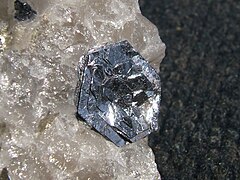Molybdenite
| Molybdenite | |
|---|---|

Euhedral molybdenite on quartz, Molly Hill mine, Quebec, Canada. The large crystal is 15 mm across
|
|
| General | |
| Category | Sulfide mineral |
|
Formula (repeating unit) |
Molybdenum disulfide (MoS2) |
| Strunz classification | 2.EA.30 |
| Crystal system | Common, 2H polytype: hexagonal 3R polytype: trigonal |
| Crystal class | 2H polytype: dihexagonal dipyramidal (6/mmm) 3R polytype: Ditrigonal pyramidal (3m) |
| Space group | 2H polytype: P63/mmc 3R polytype: R3m |
| Unit cell | 2H polytype: a = 3.16 Å, c = 12.3 Å; Z = 2 3R polytype: a = 3.16 Å, c = 18.33 Å; Z = 3 |
| Identification | |
| Color | Black, lead-silvery gray |
| Crystal habit | Thin, platy hexagonal crystals terminated by pinacoidal faces, also as tapering six-sided pyramids that can be truncated by the pinacoids. Also massive, lamellar and in small grains in sulfide ore bodies |
| Cleavage | Perfect on [0001] |
| Tenacity | Lamellae flexible, not elastic |
| Mohs scale hardness | 1–1.5 |
| Luster | Metallic |
| Streak | Bluish gray |
| Diaphaneity | Nearly opaque; translucent in thin flakes |
| Specific gravity | 4.73 |
| Pleochroism | Very strong |
| Fusibility | Infusible (decomposes at 1185 °C) |
| Other characteristics | It has a greasy feel and leaves marks on fingers |
| References | |
Molybdenite is a mineral of molybdenum disulfide, MoS2. Similar in appearance and feel to graphite, molybdenite has a lubricating effect that is a consequence of its layered structure. The atomic structure consists of a sheet of molybdenum atoms sandwiched between sheets of sulfur atoms. The Mo-S bonds are strong, but the interaction between the sulfur atoms at the top and bottom of separate sandwich-like tri-layers is weak, resulting in easy slippage as well as cleavage planes. Molybdenite crystallizes in the hexagonal crystal system as the common polytype 2H and also in the trigonal system as the 3R polytype.
Molybdenite occurs in high temperature hydrothermal ore deposits. Its associated minerals include pyrite, chalcopyrite, quartz, anhydrite, fluorite, and scheelite. Important deposits include the disseminated porphyry molybdenum deposits at Questa, New Mexico and the Henderson and Climax mines in Colorado. Molybdenite also occurs in porphyry copper deposits of Arizona, Utah, and Mexico.
...
Wikipedia
